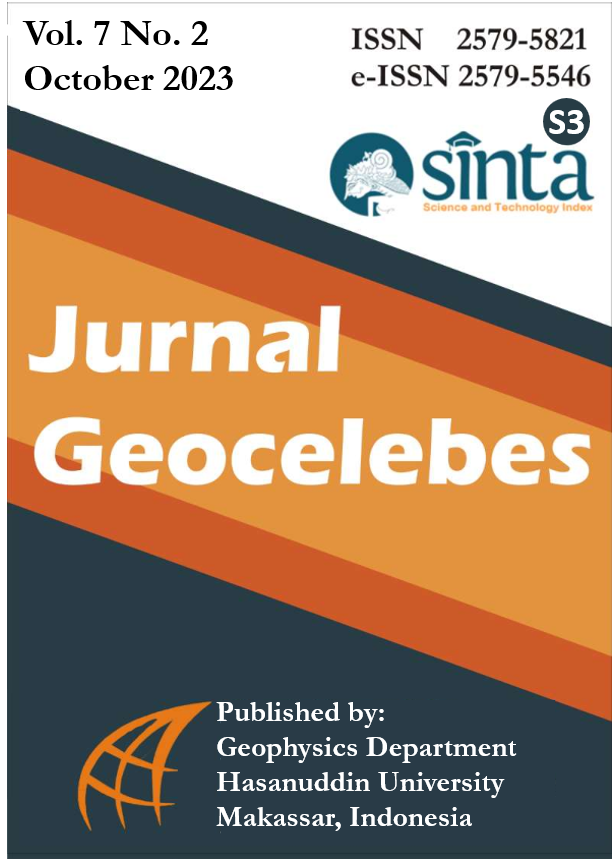Advanced Processing of 2D Marine Reflection Seismic Data Using the Common Reflection Surface (CRS) Stack Method with K-L Filter Application
Pengolahan Lanjut Data Seismik Refleksi 2D Lait Menggunakan Metode Common Reflection Surface (CRS) Stack dengan Penerapan KL-Filter
DOI:
https://doi.org/10.20956/geocelebes.v7i2.22588Keywords:
conventional stack, common reflection surface stack, K-L FilterAbstract
Data processing using the seismic reflection method is an important stage in the exploration of natural resources and minerals. This research was conducted to determine the effective and efficient stacking and filtering methods in reconstructing the subsurface geological structure of the earth from the results of data processing using ProMAX software. The data processing method used is the conventional stack and the Common Reflection Surface (CRS) stack. Aperture values of 0 ms – 50 m and 3000 ms – 150 m in the CRS stack process produce the most optimum seismic sections. Both methods produce a different quality of seismic cross-section display. The 2D cross-section model from the conventional stack method looks noisier than the results from the CRS stack method. In addition, the reflector pattern on the cross-section of the results of the CRS stack method is clearer and visible with a relatively large amplitude compared to the results of the conventional stack method. To maximize the quality of data display, data enhancement is applied, which is the K-L filter. The eigenimages value of 0.10% on the K-L filter with a horizontal window width of 120 is used to reduce random noise. Thus, an increase in the S/N ratio will be obtained in the seismic data so that the 2D cross-sectional model of the seismic reflection method can approach the original conditions of the subsurface geological structure.Downloads
References
Chen, Y., Zhang, M., Bai, M., & Chen, W. (2019). Improving the signal‐to‐noise ratio of seismological datasets by unsupervised machine learning. Seismological Research Letters, 90(4), 1552-1564. https://doi.org/10.1785/0220190028
Dani, I., & Sule, M. R. (2021). Pemodelan Seismik pada Struktur Geologi Kompleks menggunakan Metode Common Reflection Surface (CRS). Jurnal Geofisika Eksplorasi, 7(3), 164–177. https://doi.org/10.23960/jge.v7i3.135
Daruartati, H., Setyawan, A., & Kusuma, I. A. (2015). Aplikasi Metode Common Reflection Surface (Crs) Untuk Meningkatkan Hasil Stack Data Seismik Laut 2d Wilayah Perairan “Y”. Youngster Physics Journal, 4(4), 291–298. https://ejournal3.undip.ac.id/index.php/bfd/article/view/9407
Desai, A., Xu, Z., Gupta, M., Chandran, A., Vial-Aussavy, A., & Shrivastava, A. (2021). Raw nav-merge seismic data to subsurface properties with mlp based multi-modal information unscrambler. Advances in Neural Information Processing Systems, 34, 8740–8752. https://openreview.net/pdf?id=HLalhDvDwrQ
Garabito, G. (2021). Prestack seismic data interpolation and enhancement with common‐reflection‐surface–based migration and demigration. Geophysical Prospecting, 69(5), 913–925. https://doi.org/10.1111/1365-2478.13074
Hsu, K. (1990). Wave separation and feature extraction of acoustic well-logging waveforms using Karhunen-Loeve transformation. Geophysics, 55(2), 176–184. https://doi.org/10.1190/1.1442824
Hubral, P. (1983). Computing true amplitude reflections in a laterally inhomogeneous earth. Geophysics, 48(8), 1051–1062. https://doi.org/10.1190/1.1441528
Jäger, R. (1999). The common reflection surface stack: theory and application. MSc Thesis. University of Karlsruhe, Karlsruhe, Germany.
Jang, S., & Lee, D. (2022). Application of Reverse Time Migration to Faults Imaging in Rakhine Basin, Myanmar. Geofluids, 2022(1968793), 13 pages. https://doi.org/10.1155/2022/1968793
Liu, B., & Liu, Q. (2020). Random noise reduction using SVD in the frequency domain. Journal of Petroleum Exploration and Production Technology, 10, 3081–3089. https://doi.org/10.1007/s13202-020-00938-w
Mandal, B., Sen, M. K., Vaidya, V. R., & Mann, J. (2014). Deep seismic image enhancement with the common reflection surface (CRS) stack method: evidence from the Aravalli–Delhi fold belt of northwestern India. Geophysical Journal International, 196(2), 902–917. https://doi.org/10.1093/gji/ggt402
Pahlavanloo, A., Soleimani Monfared, M., & Gallo, C. (2017). Improving seismic image in complex structures by new solving strategies in the CO-CRS and the CO-CDS methods. Iranian Journal of Geophysics, 10(5), 42–56. https://dorl.net/dor/20.1001.1.20080336.1396.10.5.5.2
Prabowo, A., Junursyah, G. M. L., & Hidayat, W. (2021). Analisis Kualitas Data Magnetotelurik Berdasarkan Parameter Koherensi Pada Daerah Bandung, Jawa Barat. Jurnal Mineral, Energi, dan Lingkungan, 4(2), 78–84. https://doi.org/10.31315/jmel.v4i2.3679
Pussak, M., Bauer, K., Stiller, M., & Bujakowski, W. (2014). Improved 3D seismic attribute mapping by CRS stacking instead of NMO stacking: Application to a geothermal reservoir in the Polish Basin. Journal of Applied Geophysics, 103, 186–198. https://doi.org/10.1016/j.jappgeo.2014.01.020
Rad, P. B., & Macelloni, L. (2020). Improving 3D water column seismic imaging using the Common Reflection Surface method. Journal of Applied Geophysics, 179, 104072. https://doi.org/10.1016/j.jappgeo.2020.104072
Sharma, A., Singh, A. K., & Kumar, P. (2018). Combining haar wavelet and Karhunen-Loeve transform for robust and imperceptible data hiding using digital images. Journal of Intelligent Systems, 27(1), 91-103. https://doi.org/10.1515/jisys-2017-0032
Shukla, K., & Jaiswal, P. (2017). Wavefield-based regularization of multicomponent seismic data. SEG Technical Program Expanded Abstracts 2017 (pp. 2575-2579). Society of Exploration Geophysicists. https://doi.org/10.1190/segam2017-17794904.1
Wang, D., Gao, J., Liu, N., & Jiang, X. (2020). Structure-oriented DTGV regularization for random noise attenuation in seismic data. IEEE Transactions on Geoscience and Remote Sensing, 59(2), 1757–1771. https://doi.org/10.1109/TGRS.2020.3001141
Zaharov, V. V., Farahi, R. H., Snyder, P. J., Davison, B. H., & Passian, A. (2014). Karhunen–Loève treatment to remove noise and facilitate data analysis in sensing, spectroscopy and other applications. Analyst, 139(22), 5927–5935. https://doi.org/10.1039/C4AN01300J
Zhu, L., Liu, E., & McClellan, J. H. (2015). Seismic data denoising through multiscale and sparsity-promoting dictionary learning. Geophysics, 80(6), WD45-WD57. https://doi.org/10.1190/geo2015-0047.1
Downloads
Published
How to Cite
Issue
Section
License
Authors who publish with this journal agree to the following terms:
- Authors retain copyright and grant the journal right of first publication with the work simultaneously licensed under a Creative Commons Attribution License that allows others to share the work with an acknowledgement of the work's authorship and initial publication in this journal.
- Authors are able to enter into separate, additional contractual arrangements for the non-exclusive distribution of the journal's published version of the work (e.g., post it to an institutional repository or publish it in a book), with an acknowledgement of its initial publication in this journal.
- Authors are permitted and encouraged to post their work online (e.g., in institutional repositories or on their website) prior to and during the submission process, as it can lead to productive exchanges, as well as earlier and greater citation of published work (See The Effect of Open Access).



